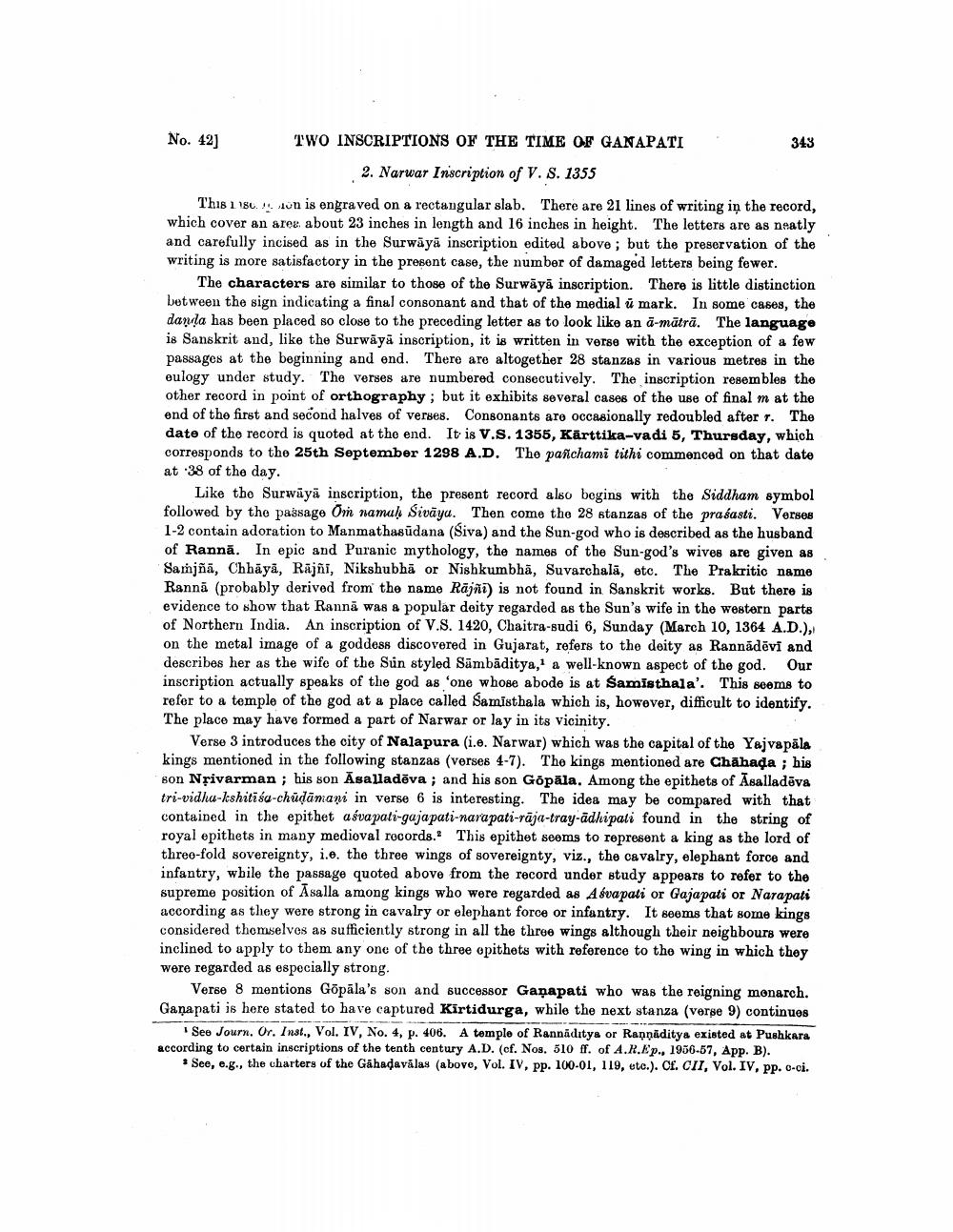________________
No. 42]
TWO INSCRIPTIONS OF THE TIME OF GANAPATI
343
2. Narwar Inscription of V. S. 1355 This 1180. Ton is engraved on a rectangular slab. There are 21 lines of writing in the record, which cover an ares about 23 inches in length and 16 inches in height. The letters are as neatly and carefully incised as in the Surwäyā inscription edited above; but the preservation of the writing is more satisfactory in the present case, the number of damaged letters being fewer.
The characters are similar to those of the Surwäyä inscription. There is little distinction between the sign indicating a final consonant and that of the medial mark. In some cases, the danda has been placed so close to the preceding letter as to look like an a-mātrā. The language is Sanskrit and, like the Surwāya inscription, it is written in verse with the exception of a few passages at the beginning and end. There are altogether 28 stanzas in various metres in the eulogy under study. The verses are numbered consecutively. The inscription resembles the other record in point of orthography; but it exhibits several cases of the use of final m at the end of the first and second halves of verses. Consonants are occasionally redoubled after 1. The date of the record is quoted at the end. It is V.S. 1355, Kärttika-vadi 5, Thursday, which corresponds to the 25th September 1298 A.D. The panchami tithi commenced on that date at 38 of the day.
Like the Surwīyā inscription, the present record also begins with the Siddham symbol followed by the passage Om namah Sivāyu. Then come the 28 stanzas of the prasasti. Verses 1-2 contain adoration to Manmathasüdana (Śiva) and the Sun-god who is described as the husband of Ranna. In epic and Puranic mythology, the names of the Sun-god's wives are given as Samjña, Chhaya, Rajni, Nikshubhā or Nishkumbhā, Suvarchala, eto. The Prakritic name Rannā (probably derived from the name Rājñi) is not found in Sanskrit works. But there is evidence to show that Rannā was a popular deity regarded as the Sun's wife in the western parts of Northern India. An inscription of V.S. 1420, Chaitra-sudi 6, Sunday (March 10, 1364 A.D.), on the metal image of a goddess discovered in Gujarat, refers to the deity as Rannadēvi and describes her as the wife of the Sun styled Sümbāditya,' a well-known aspect of the god. Our inscription actually speaks of the god as one whose abode is at Samisthala'. This seems to refer to a temple of the god at a place called Samīsthala which is, however, difficult to identify. The place may have formed a part of Narwar or lay in its vicinity.
Verse 3 introduces the city of Nalapura (i.e. Narwar) which was the capital of the Yajvapāla kings mentioned in the following stanzas (verses 4-7). The kings mentioned are Chahada ; his son Nțivarman ; his son Asalladēva ; and his son Gopāla. Among the epithets of Āsalladava tri-vidhu-leshitisa-chūdāmani in verse 6 is interesting. The idea may be compared with that contained in the epithet aśvapati-gajapati-narapati-rāja-tray-ādhipali found in the string of royal epithets in many medioval rocords. This epithet seems to represent a king as the lord of threo-fold sovereignty, i.e. the three wings of sovereignty, viz., the cavalry, elephant force and infantry, wbile the passage quoted above from the record under study appears to refer to the supreme position of Asalla among kings who were regarded as Afvapati or Gajapati or Narapati according as they were strong in cavalry or elephant force or infantry. It seems that some kings considered themselves as sufficiently strong in all the three wings although their neighbours were inclined to apply to them any one of the three epithets with reference to the wing in which they were regarded as especially strong
Verse 8 mentions Gopāla's son and successor Ganapati who was the reigning monarch. Ganapati is here stated to have captured Kirtidurga, while the next stanza (verse 9) continues
Seo Journ. Or. Inst., Vol. IV, No. 4, p. 406. A temple of Rannāditya or Rappiditya existed at Pushkara according to certain inscriptions of the tenth century A.D. (cf. Nos. 510 ff. of 4.2.6 p., 1956-57, App. B).
* See, e.g., the charters of the Gahadavālas (above, Vol. IV, pp. 100-01, 119, etc.). Of. CII, Vol. IV, pp. o-ci.




